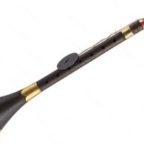Sorna; Persian Musical Instrument
The sornā belongs to the family of single reed and double reed aerophones. This instrument is widespread in most areas of Iran and is called by other names such as sornāy, surnā and surnāy and in some areas it is known by its proper name.
The cylindrical body with a trumpet-shaped opening, two inner tubes, an outer body, a reed and a mouthpiece, make up the main parts of this instrument which has 7 acoustic holes on the front (in some cases 5 or 6) and a hole on the back.
The body of the sornā is of wood. The method of blowing in the sornā is continuous and is performed with a particular method of called breath nafas bargardan. The sornā, which is the main instrument that accompanies marriages and feasts of tribes, nomads and villages, in areas such as Lorestān, Kermānshāh, Ilām and Bakhtiāri is played in mourning ceremonies and in other areas on the occasion of tazieh (religious theatrical performances).
In the past it was part of the instruments of naghāreh khāneh. Various types of dahol, naghāreh, tombak, and dāyereh are instruments of accompaniment to the sornā.

